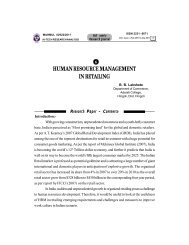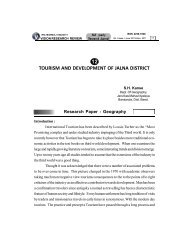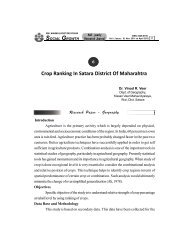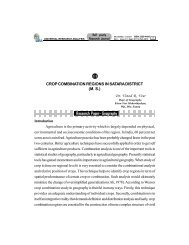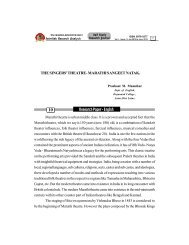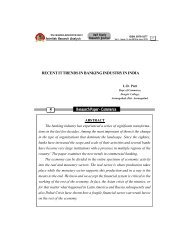A Geographical Study Of Food Grain Cropping Pattern
A Geographical Study Of Food Grain Cropping Pattern
A Geographical Study Of Food Grain Cropping Pattern
Create successful ePaper yourself
Turn your PDF publications into a flip-book with our unique Google optimized e-Paper software.
UNIVERSAL RESEARCH ANALYSIS<br />
Half yearly<br />
Research Journal<br />
RNI. MAHMUL 13/2/2010 ISSN 2229-4406<br />
Vol. I , Issue :I I I, Sept. 2011 to Feb. 2012<br />
A <strong>Geographical</strong> <strong>Study</strong> <strong>Of</strong> <strong>Food</strong> <strong>Grain</strong> <strong>Cropping</strong> <strong>Pattern</strong> In Solapur<br />
Dr. Govindrao U. Todkari<br />
Dept. of Geography,<br />
Shri Sant Damaji College,<br />
Mangalwedha. Dist. Solapur<br />
ABSTRACT<br />
In this paper an attempt has been made to analyse the foodgrain<br />
cropping pattern at micro level in Solapur District. This study is based on secondary<br />
data collected from secondary records. Agriculture production is influenced by<br />
physical, climatological, socio-economic, technological and organization factors.<br />
Solapur district occupies southern part of Maharashtra state. It occupies an area<br />
of 14,84559 sq.km. And supports 32.32 lack of population in 2001 censes.<br />
Administrative the district is divided in to eleven tahsils. Physiography, temperature,<br />
rainfall, soil and drainage influence on agriculture landuse pattern in this district.<br />
Temperature is high in summer. Because of district is located in drought prone area<br />
of Maharashtra<br />
Keywords :- staple food, physical environment, human reaction, dominant role, rain<br />
Introduction<br />
fed crop, tropical crop<br />
12<br />
District <strong>Of</strong> Maharashtra<br />
Research Paper - Geography<br />
A.J. Barakade<br />
Dept. of Geography,<br />
K. B. Patil College,<br />
Pandharpur, Dist. Solapur.<br />
Landuse pattern is a key to understand geographical adjustment of agricultural<br />
recourses (Balak Ram and Joshi 1984). Landuse study in its spatial contest is essential to<br />
6 1
UNIVERSAL RESEARCH ANALYSIS<br />
Half yearly<br />
Research Journal<br />
RNI. MAHMUL 13/2/2010 ISSN 2229-4406<br />
Vol. I , Issue :I I I, Sept. 2011 to Feb. 2012<br />
understand regionalization of the areas of optimum landuse. (Shinde S D & eatil.) landuse<br />
studies are important as they are aimed to explained to explain the occurrence of different<br />
uses in different areas. Landuse in which human efforts are applied to the land recourses<br />
for the satisfaction of human needs. It is essential to understand the variation in the landuse<br />
as a human reaction to words the satisfaction of human wants.<br />
<strong>Study</strong> Region<br />
The present study deals with the geographical perspectives of the agriculture in<br />
Solapur district. The Solapur district is bounded by 17º05' North latitudes to 18º 32'<br />
North latitudes and 74º42' east to 76º15' East longitudes. The total geographical area of<br />
Solapur district is 14895 K.m². divided into eleven tahsils.<br />
Climate of the district is dry. The daily mean maximum temperature range<br />
between 30º C to 35º C and minimum temperature range between 18ºC to 21ºC. The<br />
highest temperature is 47º C recorded in the month of May. The average annual rainfall is<br />
registered 510 mm. The soil of the district essentially derived from the Deccan trap. The<br />
soil of the district can broadly classify into three groups shallow, medium and deep soil.<br />
Objectives<br />
The following are the aims and objectives of the present study.<br />
1. To represent the agricultural landuse specially foodgrains, i.e., jowar, wheat, Maize,<br />
bajara and rice.<br />
2. To study the impact of physical and nonphysical factors on agriculture.<br />
3. For the study of spatio-temporal analysis of foodgrain crop in Solapur district.<br />
4. To find out the problems and suggest some remedies.<br />
5. To draw the conclusions regarding foodgrain cropping pattern in Solapur district.<br />
Research methodology<br />
Present study mostly relies on the secondary data collected through Agriculture<br />
Department and District statistical Department of Solapur and District socio-economic<br />
abstract of Solapur District. For the present investigation, District is selected as in general<br />
and tahsils in particular. The statistical and cartographic techqunices are used for repre-<br />
sentation of food grain cropping pattern.<br />
6 2
Explanation<br />
UNIVERSAL RESEARCH ANALYSIS<br />
Half yearly<br />
Research Journal<br />
RNI. MAHMUL 13/2/2010 ISSN 2229-4406<br />
Vol. I , Issue :I I I, Sept. 2011 to Feb. 2012<br />
<strong>Food</strong> grains play a major role in the cropping of land under tillage in Solapur<br />
district. For only, under food grains can they produce enough to sustain the dense population<br />
in the study region. Moreover, food grain crops are relatively less demanding and less<br />
exacting in their soil moisture requirements than fiber crops. High percentages under food<br />
grain are noted in the western part of the district. Overall, the cereals and pulses domi-<br />
nate the agriculture land-use crop of the region.<br />
1) Jowar<br />
Jowar is first in importance as a staple crop in Solapur district. Its botanical<br />
name is sorghum vulgare. Jowar is also known as great millet. Among all the food grains<br />
in the region, it is a staple food crop of the rural population. It is a first ranked crop.<br />
Jowar is a leading crop in the study region occupying about 60.45 percent (748200<br />
hectares) in 1980-81, but it was 51.04 percent (482400 hectares) of the total cultivated<br />
area in 2004-05. It decreased by 9.41 percent in the investigated period because non-food<br />
grains replaced the jowar area. The main improved varieties grown in the region are<br />
C5H5,CH5,M35-1 and local kharif Jowar.<br />
Environmental Requirements :-<br />
Jowar is purely a tropical crop. The crop thrives well under the condition of high<br />
temperature requiring mean temperature of over 27º c and moderate rainfall between<br />
350 mm to 900 mm. Jowar is grown on heavy and light alluvium to red ,medium black to<br />
deep black and even sandy soils. It is mostly cultivated in kharif as well as rabi season but<br />
in the study region, it is mainly cultivated in rabi season.<br />
Spatial Distribution :-<br />
Spatial distribution of jowar crop in the study region vary from tahsil to tahsil in<br />
the reference year 2004-05. The area under jowar crop was very high (74.94 percent)<br />
in Mangalwedha then followed by North Solapur(67.63 %), Sangola(63.68 %) and<br />
Mohol(60.71%). Below 30 percent, area under this crop is observed in Malshiras,<br />
Pandharpur and Karmala tahsils. The remaining tahasil has covered area between 30 to<br />
60 percent under this crop of the net sown area.<br />
6 3
UNIVERSAL RESEARCH ANALYSIS<br />
Temporal Analysis :-<br />
In general ,the area of jowar has<br />
decreased in all the tahsils in the district<br />
except Mangalwedha and Barshi tahsils.<br />
The area under jowar declined by about<br />
4 percent to 40 percent in the period from<br />
1990-91 to 2004.05 in all over the dis-<br />
trict. However, the area of this crop in-<br />
creased in Mangalwedha (14.49 percent)<br />
and Barshi (3.76 percent) tahasil.<br />
Mangalwedha is a major producer of<br />
Maldandi jowar in the study region as<br />
well as in Maharashtra. In Mangalwedha<br />
tahasil 60.45 percent area was under this<br />
crop in 1990-91 and it increased in<br />
2004-05 i.e. 74.94 percent .<br />
2) Wheat<br />
Wheat is the second important<br />
food crop in Solapur district. The bo-<br />
tanical name of wheat is Triticum Satuvum<br />
. Wheat ranks second among the food<br />
grains grown in the district. It accounted<br />
for 3.97 percent land in 1990-91, which<br />
increased by 7.01 percent of the net sown<br />
area in 2004-05.. Farmers grew wheat<br />
on small scale everywhere in the study<br />
area.<br />
Environmental Requirements:-<br />
Wheat is mainly a rabbi crop. It<br />
is adapted to varying condition of climate<br />
Half yearly<br />
Research Journal<br />
RNI. MAHMUL 13/2/2010 ISSN 2229-4406<br />
Vol. I , Issue :I I I, Sept. 2011 to Feb. 2012<br />
Table No 1<br />
6 4
UNIVERSAL RESEARCH ANALYSIS<br />
Half yearly<br />
Research Journal<br />
RNI. MAHMUL 13/2/2010 ISSN 2229-4406<br />
Vol. I , Issue :I I I, Sept. 2011 to Feb. 2012<br />
and soil. It grows better in winter temperature between 15ºc and 20ºc ; rainless days<br />
with clear and bright sunshine during ripening and harvesting period are necessary to<br />
have a better quality of grains. It can be grown in the areas where rainfall is less than 500<br />
cm , with the help of irrigation. Frost at flowering time and hailstorms when the grain is<br />
almost ripe damage the crop . Wheat is produced in the loams ,clay soils and medium<br />
black soils in the study region.<br />
Spatial Distribution :-<br />
The regional pattern of wheat distribution in table No 4.9 shows that the<br />
expansion of this crop in areas where irrigation is more developed as in 2004/05. The highest<br />
percentage of area under wheat is at Pandharpur (21.12 %) and Malshiras (20.88 %) .<br />
Temporal Analysis: -<br />
It may be observed from Fig No 4.10 that the area under wheat cultivation was<br />
3.97 percent in 1990-91, which increased to 7.01 percent of the net sown area in 2004-<br />
05. However, it did not increase in all tahsils of the district. It increased highly (above 10<br />
%) in Pandharpur and Malshiras tahsils and also increased to small extent (0.5 % to 3<br />
%) in North Solapur, South Solapur, Madha , Sangola and Akkalkot tahsil. The area<br />
under this crop highly decreased (below 4 %) in Karmala Mangalwedha, Mohol and<br />
Barshi.<br />
3) Bajara<br />
Bajara is the third food grain crop in the study region. It plays a very dominant<br />
role in the economy of the study region. It is a staple food of a very large part of the<br />
population in the district. It also provides good quality fodder for the livestock.<br />
Environmental Requirements:-<br />
Bajara is a typical tropical plant and usually thrives in warm and drier types of<br />
climate. The suitable temperature for bajara crop is 25ºc to 35ºc. The most important of<br />
all environmental factors is the fact that there should be a minimum rainfall from 150 to<br />
200 mm . Bajara thrives in poor to medium soil as well as in black cotton soils. Bajara is<br />
a kharif crop and is sown in June-July.<br />
Spatial Distribution :-<br />
Bajara crop is raised all over the study area to a small extent (4.78 %), but it is<br />
6 5
UNIVERSAL RESEARCH ANALYSIS<br />
Half yearly<br />
Research Journal<br />
RNI. MAHMUL 13/2/2010 ISSN 2229-4406<br />
Vol. I , Issue :I I I, Sept. 2011 to Feb. 2012<br />
specially concentrated in Western, Eastern and Southern parts of the study area or away<br />
from Sina, Bhima and Man rivers.<br />
Temporal Analysis: -<br />
In 1990-91, the area under bajara crop was 2.68 percent, which increased to<br />
2.90 percent of the net sown area in 2004-05 and increased by 2.10 percent of the net<br />
sown area. The area under bajara crop decreased (below 2 %) in Sangola and<br />
Mangalwedha tahsils. It decreased because the area under pomegranate and bor<br />
increased largely. It increased in all remaining tahsils of the study region by 0.50 to 5.00<br />
percent of the net sown area.<br />
4) Maize<br />
Maize is the fourth most important food grain in the study area. It is locally<br />
called Maka. It covered 1.42 percent of the net sown area in 1990-91 and 2.90 percent<br />
in 2004-05, it increased by 1.91 percent of the net sown area. Farmers grow maize on<br />
a small or large scale everywhere in the study area. It increased because it is largely<br />
used for livestock or growth of dairy farming.<br />
Environmental Requirements:-<br />
Maize is a food grain which grows well in well-drained alluvial soil and black<br />
cotton soil. It requires warm and moist geographical condition. Maize is a rabbi crop<br />
grown in the month of winter season between October and March, so it needs irrigation<br />
facility. It is entirely produced as an irrigated crop.<br />
Spatial Distribution :-<br />
The area under Maize crop covered 2.90 percent (27300 hectares) of the net<br />
sown area of the region. The highest percentage of area under this crop is at Malshiras<br />
(8.37 %) and then follow Pandharpur (6.58 %) and Sangola (6.06 %). Moderate<br />
percentage (3 to 6 %) of maize crop is at Mohol, whereas the lowest area (below 3 %)<br />
of this crop is observed in Akkalkot, South Solapur, Mangalwedha, Karmala, Madha,<br />
Barshi and North Solapur tahsil.<br />
Temporal Analysis: -<br />
Table No 4.11 and Fig No 4.11 show that in 1990-91 maize occupied about<br />
1.91 percent while in 2004-05 its area increased by 2.90 percent of the total net shown<br />
6 6
UNIVERSAL RESEARCH ANALYSIS<br />
Half yearly<br />
Research Journal<br />
RNI. MAHMUL 13/2/2010 ISSN 2229-4406<br />
Vol. I , Issue :I I I, Sept. 2011 to Feb. 2012<br />
area of the region. The area under this crop largely (above 4 %) increased in Malshiras<br />
and Sangola tahsils whereas it increased to some extent in Pandharpur (2.34 %) Mohol<br />
(0.87 %) and Barshi (0.96 %). The area under this crop decreased in Northeastern and<br />
Eastern tahsil of the district because in this area irrigation is not well developed.<br />
5) Rice<br />
Rice is most commonly known by local name Bhat. It is the most common<br />
crop in a tropics. The botanical name of rice is oriza sativa. Rice is predominantly a rain<br />
fed crop. Rice ranks fifth among the crops grown in the district and accounts for a smaller<br />
aerial coverage. The main improved varieties grown in the region are IR8, Jaya, Suhasini,<br />
Karjat 184, Ratnagiri 24 etc which give better yields.<br />
Environmental Requirements :-<br />
Rice is a tropical monsoon crop requiring high temperature and high rainfall.<br />
Distribution of rice depends on agro climatic conditions. The climate of the area plays<br />
a more important role than soil in production of rice.<br />
Spatial Distribution :-<br />
In the reference year 2004/05, rice was grown more or less in all talukas of the<br />
district. <strong>Of</strong> these high i.e. only above 0.50 percent of the net sown area was covered in<br />
Akkalkot, South Solapur and Malshiras. The remaining area under rice was very low i.e.<br />
only below 0.50 percent of the net sown area.<br />
Temporal Analysis :-<br />
During the period under consideration, a very little change has taken place in the<br />
study region as shown in Fig No 4.13 and Table No 4.12. In 1990-91, rice covered<br />
0.35 percent of the net sown area, it slightly decreased in 2004-05 and covered an<br />
area of 0.34 % of the net sown area. In general, the area under rice decreased in all<br />
talukas except Madha, Barshi, South Solapur and Mangalwedha tahsils.<br />
CONCLUSION<br />
<strong>Food</strong>grains like jowar, wheat, Maize, bajara and rice crops occupied maximum<br />
area, i.e., 72.23 % in 1991/92 and in 2004/05 it was 66.07 % out of the agriculture<br />
area. Jowar is the most important crop of the study region. Jowar crop occupied<br />
maximum area than other crops. There is slight decrease in area during investigation<br />
6 7



